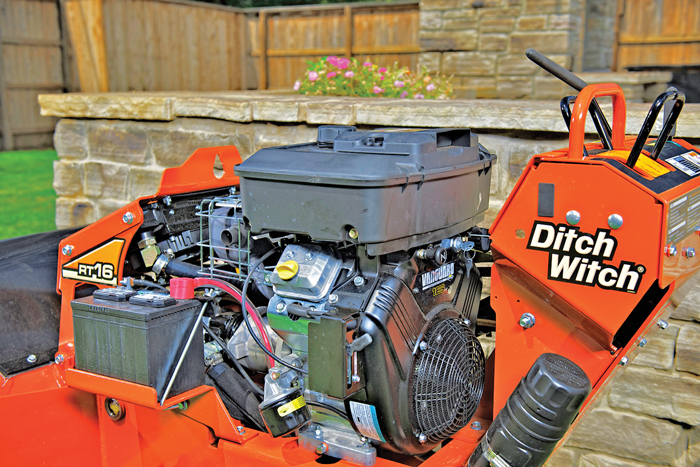Walk-Behind Trencher Maintenance
 No one disputes that properly maintained construction equipment is more productive, breaks down less frequently on the job and is worth more when the time comes to sell or trade it in. Yet, properly maintaining equipment is a continuing challenge for many owner-operators. Every type of machine comes with an owner’s manual that recommends essential maintenance procedures and the intervals at which each should be performed. However, simply having the manual does no good unless the maintenance recommendations it contains are implemented.
No one disputes that properly maintained construction equipment is more productive, breaks down less frequently on the job and is worth more when the time comes to sell or trade it in. Yet, properly maintaining equipment is a continuing challenge for many owner-operators. Every type of machine comes with an owner’s manual that recommends essential maintenance procedures and the intervals at which each should be performed. However, simply having the manual does no good unless the maintenance recommendations it contains are implemented.
Trenchers — one of the primary product categories in utility and general construction — is a class of equipment that requires daily attention if it is to be maintained in top condition. A compact walk-along trencher’s sole function is to dig a trench in which cable or pipe is placed. These machines are used routinely by plumbers, landscapers and electricians, among others, and they are readily available from rental stores who serve both professionals and do-it-yourself homeowners. There is no doubt that rental equipment is abused more than privately owned equipment and that rental equipment users may lack the experience that owner-operators have with their equipment. This abuse and lack of experience may result in maintenance issues that require immediate attention.
The primary wear parts on any chain-type trencher are the digging teeth, digging chain and sprockets. Operating a trencher with worn or damaged teeth, chain or sprockets reduces digging efficiency and places extra stress on the machine. This causes unnecessary wear and possible damage to other components. The more difficult the soil conditions, the more often these components must be replaced.
Inspect digging teeth and the chain daily or after each job. Sharp digging teeth are important to digging a trench. Dull, worn digging teeth decrease production and increase shock load to other trencher components. Also, the percentage of wear to the “cup” of the tooth directly corresponds to its trench cleaning efficiency. Tooth pattern matters, so replace teeth to conform to the tooth pattern on the digging chain. Insert bits are designed to rotate during trenching. If dirt or small pieces of rock lodge in the sockets (that hold each bit) preventing rotation, the bit will wear unevenly. Simply turning a bit usually removes dirt and debris. If a bit can’t be easily turned by hand, remove it and clean the inside of the socket. Also check for bit wear, and replace insert bits before they completely wear away. Continued use of worn bits eventually can damage bit holders on the chain, resulting in unnecessary expense.
A worn digging chain does not run smoothly and can generate shock loads which may damage other components of the machine. Inspect the digging chain, including roller links, for wear and correct tension. An incorrectly tensioned chain reduces trenching performance, and the chain may slip off the sprockets. Putting a chain back on sprockets in the field is not an easy task. Refer to the operator’s manual for proper chain tension and procedures for making adjustments.
A worn chain indicates it is also time to inspect the sprockets, replacing them when necessary. When new sprockets are installed, it is recommended that the digging chain also be replaced. Operating an old, worn chain on new sprockets causes premature sprocket wear, and running a new chain on worn sprockets causes excessive chain wear and can contribute to chain failure. For most efficient trenching, chain and teeth should be matched to soil conditions. Cup teeth perform well in soft and medium soils, and in sticky soils such as clay. However they are not recommended for rocky conditions. Shark Teeth, either welded or bolt-on style or carbide insert bits, are best suited for digging through frozen ground and/or rock. For jobs containing a mixture of soils, a “combination” chain with both cup teeth and carbide bits often provides the best results.
Walk-behind trenchers are available in rubber tire and track models. The frame and power source on these trenchers also require maintenance prior to sending one out on a job. Check engine oil and coolant levels on a regular basis, adding the correct fluids as necessary. Change fluids and filters at prescribed intervals, more frequently when operating in adverse or dusty conditions. Lubricate all service points and maintain the hydraulic system at intervals prescribed by the manufacturer. Adjust chain or belts drives as necessary, and always replace all guards and shields.
At Ditch Witch, we work every day with contractors and rental businesses who own trenchers. We find the lack of a maintenance policy and schedule are two of the primary causes for improperly serviced machines. It is essential to have an established maintenance program and to adhere to it.
While different makes and models may have different service points and service intervals, there are basic steps that apply to walk-behind trenchers (see the sidebar).
Matt Collins is a senior product manager for compact and heavy-duty equipment at Ditch Witch, based in Perry, Okla.
A Daily Walk-Behind Trencher Service Checklist
Warning: All Service Should
Be Performed with the Engine Off
1. Check engine oil and if low, add gas engine oil to highest line on the dip stick.
2. Check air filter elements each day when operating in dusty conditions.
3. Check hydraulic fluid level. Before each use with the digging boom fully raised, check fluid at sight glass. If low, add the correct fluid until level is at mid-level in the sight glass.
4. Check hydraulic fluid cooler. Inspect hydraulic fluid cooler for debris before each use. If dirty, clean by blowing with low-pressure air.
5. Lube pivot head shaft bearing with multi-purpose grease (MPG) after each use. Operate boom lift control to distribute grease along the bearing plate.
6. Lube pivot bushing after each use, pumping MPG into both grease zerks (top and bottom of pivot) until grease is visible at the pivot.
7. Lube the trail wheel after each use, pumping MPG into zerk until grease is visible at the wheel.
8. Lube auger bearing after each use by pumping MPG into zerk until grease is visible at bearing and inspect bearing support for damage. Lube wheel tracks with MPG after each use. Pump two to three pumps of MPG into grease zerk at hub.
9. Lube tracks (if applicable) with two or three pumps of MPG into zerk at each hub after each use.
10. Check tire pressures (if applicable) maintaining bar lug tires at 15 psi and turf tires at 22 psi.
11. Check digging chain tension and digging teeth condition after each use. With the boom horizontal, measure the distance from the bottom of the boom to chain. A properly tensioned chain should measure 1.5 to 2 in.
12. Lube the tail roller after each use if using a greasable roller, by pumping MPG into grease zerk in the tail roller until grease is visible at the roller bearings.
13. Fill fuel tank with recommended fuel to the bottom of the filler neck. Do not fill to the top of filler neck.




